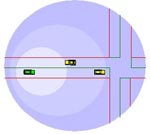Customer: DG ΧΙΙΙ
Duration: April 1998 – October 2000
In rural environment (limited number of lanes, simple intersections, various types of curves, non optimum infrastructure, limited numbers of vulnerable road users) 28% of injury accidents take place, accounting for 58% of deaths. Most of them have been related to problems in driven vision and vehicle conspicuity, poor judgement of drivers’ speed, driver merging difficulties in junctions and lane change errors (even in only two lane streets).
Hence, the aim of IN-ARTE is to develop an integrated autonomous on-board system to be able to build an extended view of the environment in front of the vehicle, integrating signals from anticollision radar, road recognition CCD sensor, digital road map, and navigation system in order to guide and warn the driver through an optimum HMI in a series of rural areas related traffic tasks, such as intersection handling, speed selection while negotiating curves, obstacle detection, etc. If the driver does not respond to the system warnings, the system will undertake the vehicle control for accident avoidance.
This integrated approach will improve the performances of today driver support systems (Adaptive Cruise Control, Collision Warning, Lane Recognition, Navigation) in the highway scenario and extend their field of operation in the more complex rural environment.
Role of TREDIT:
– Definition of criteria for system activation, driver warning and various phases of vehicle control.
– Definition of ways of driver warning according to the imminent risk

